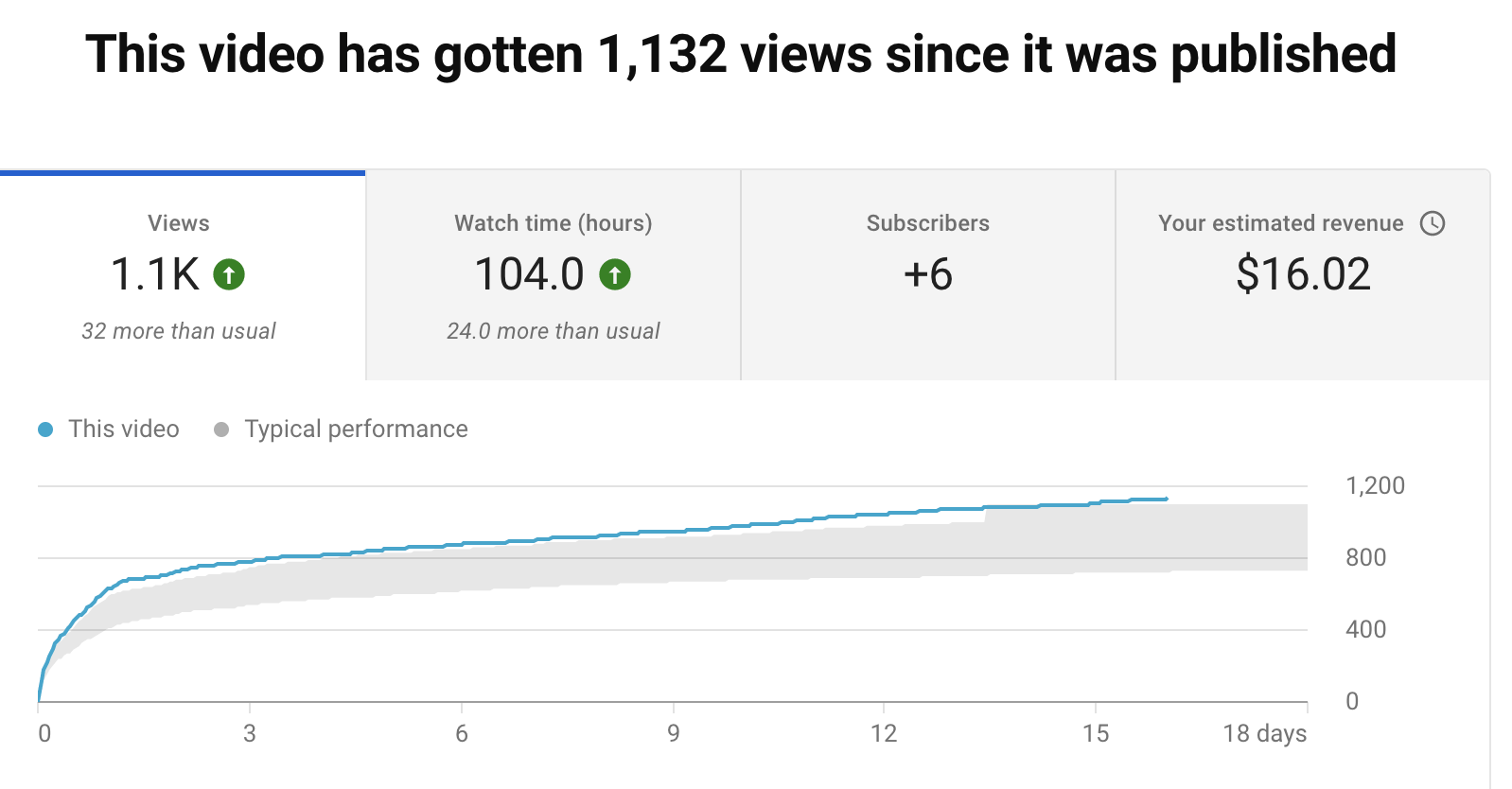5 Alternatives to YouTube Monetization for Video Creators
Photo by Matheus Bertelli from Pexels
These don’t require 1,000 subscribers or advertiser money.
I love creating videos on YouTube but recently I’ve begun to search for alternatives. Why? Because YouTube monetization is hard to achieve, and even once you’ve achieved it, there’s no guarantee that YouTube monetization will actually earn you much money at all.
There are benefits to creating videos on YouTube. For one, it’s easy - you can upload and go. I’ve made just under 100 videos, earned around $2,000, and gained 8,000 subscribers in the year and a half since I began uploading. Plus, you don’t need to be a savvy marketer or salesperson, because YouTube monetization relies on advertisers rather than you distributing and selling your own content. However, this means the relationship between the actual value of your video to viewers and how much money you get from it are totally independent. Instead of your viewers deciding how much your content is worth to them, advertisers decide how much your viewers are worth to them, the advertisers.
Screenshot of the YouTube monetization for my video with ~1000 views.
This means that alternatives to YouTube monetization are growing more and more interesting to video creators, especially as we begin seeing stronger creator-consumer relationships that don’t rely on middlemen or advertisers, like paid newsletters.
Let’s get into five alternatives to YouTube monetization that don’t rely on hours of viewed content, subscribers, or what advertisers think your viewers are worth.
Tap Into the Microconsulting Market With Wisio
YouTube is good at letting you create a relationship with your viewers. I, at least, really enjoy answering my YouTube comments and having another way to give back to the people who consume my content.
Wisio takes it one step further and lets your viewers actually reward you for answering their questions. This is a great alternative to YouTube monetization for anyone who teaches anything in their videos, or who has especially invested fans. The benefit of this platform is that it lets you continue building on your relationship with your viewers on a more one-on-one basis. The way it works is you set up different types of questions to be answered (for example, $20 for a 2-minute personalized video answering a personal question, $120 for a 10-minute video review of a submitted blog post draft) and then promote your account to your existing audience.
There’s a real personalized note when it comes to answering a question directly. Sometimes you can’t really convey the depth or breadth of your thoughts and expertise on a subject in a written comment, so this method lets you sate your viewers’ appetites for more of you and your knowledge.
It also taps into the market for consulting. People pay a lot of money for an hour of an expert’s time - by shrinking the scale down to a micro-consultancy scale, you can increase the potential audience for your services.
The benefits of this alternative to YouTube monetization is you get to piggyback on your existing audience and allow them greater access to you. This strengthens your relationships while putting the financial control back in the hands of you and your viewers.
2. Set Up Your Patreon to Earn Money Per Video Posted
Patreon is part of what’s driving this sort of slow, inevitable realization that creators should get paid in proportion to the value they create for viewers. Patreon has two monetization plans creators can choose from: a monthly membership with tiered options, and a pay-per-content, where creators get paid when they post a new piece of content like a video.
This second mechanism is a great alternative to YouTube monetization because it puts the control in your hands without any advertisers at all. I first did this when I subscribed to Ryan Dunleavy for his maps of Blades in the Dark, an RPG my husband and I played with a group of friends. I needed maps for our game, he was providing them at $5 a pop, plus access to any previous maps he had created. For me, it was a bargain. For him, he got value for the content he created.
This method works really well for creators because the value is evident and it makes it easy for consumers to decide whether it’s worth it or not to them. Plus, the longer the creator keeps going, the more value there is for the consumer of that content, who gets access to the backlog. If you wanted an alternative to YouTube monetization, you could set up a Patreon where you release once-monthly videos at $10 per video. With just 10 subscribers, you’d earn $100 per month for a single video from viewers who really value your work. If ten people watched my video on YouTube, I’d earn perhaps a penny, no matter how many hours of work I put into it.
The advantages of Patreon are this: the platform is easy to use, there are no advertisers involved at all, and consumers get to decide how much they value your content. Compare that to YouTube’s monetization method where you need thousands of views to earn much money at all.
3. Sell Your Videos at a Premium with MakerStreamer
The downside to Patreon is that the expectation of pricetag is already set low. Patrons expect to pay between $3-20 on Patreon, whether on a monthly subscription or on a per-content basis. If you’re a video creator who spends meticulous hours of work and who wants to earn more than $100 per month with your videos, you need a huge volume of subscribers.
That’s what makes MakerStreamer such an enticing alternative both to YouTube monetization and places like Patreon - the average transaction there is estimated to be $47, rather than Patreon’s average of $6. Consumers come ready to pay more money for premium content.
Take a look at Five Pencil Method as an example. Darrel earns over $11,000 per month by selling videos on MakerStreamer, priced slightly higher than Patreon’s typical content. Again, there are two options for monetization - viewers can choose to purchase one-off videos, or they can subscribe for membership of ongoing videos.
This dual-natured monetization plan means that again, the choice is in the viewer’s hands to see how much they value their work. Again, unlike YouTube monetization, there are no advertisers who place a value on your viewers’ worth to them - the focus is on your relationship with your viewers.
4. Sell Seminars on Your Own Website
One of the strengths when it comes to YouTube monetization is the royalty scheme. You can create a video in January 2021, and in December 2021 it’s still earning money - without any additional needed effort expenditure on your part. You can have that literal passive income without needing to rely on advertisers by selling webinars on your own website.
For example, I could create a seminar on some of my best-earning blog post templates. I might price it at $40. The only difficulties would be finding a way to host this content, deliver it, and manage the money income. The good news is many websites, like my own Squarespace website, do this already on a few of their paid plans.
This does require some work - for instance, you have to market your own videos, you have to refresh them if they get out of date, you have to drive traffic to your site to increase your potential buyer audience - but unlike microconsulting, you don’t need to continue creating content to get paid. You create a good video once and sell it for years to come.
This is a great alternative to YouTube monetization because it allows you to play to your strengths, receive passive income, and get paid for the value you create by the people you’re creating the actual value for, rather than advertisers.
5. Monetize Your Talents on Twitch
Lately, a lot of gamers have been in the news for their high-paying video games. Like sports, talented players will stream their games, even earning millions per year just by playing video games for their fans to watch. What I didn’t know is that it’s also possible to stream other things and earn money, like your commentary on other people’s games.
For example, T90 is a caster who makes his living by commentating on other people’s Age of Empire games. He played for a few years and streamed those games, but really found his calling and his fanbase when he began to commentate on the games of others.
While he doesn’t make millions, he is estimated to have a net worth in the hundreds of thousands - not by being monetized on YouTube or having many advertisers or even sponsors. The bulk of his income comes from him streaming his commentary on Twitch, and hundreds of thousands of devoted viewers rewarding him for his content.
Twitch is definitely an up-and-coming alternative to YouTube monetization because there aren’t any restrictions to begin monetizing, and there’s a much better-established viewer-to-creator financial relationship. Twitch viewers can purchase memberships, gifts, and other marks of their devotion to their favored streamer.
And there’s a much broader scope for what it’s possible to stream. On YouTube, most streamers are gamers. On Twitch, you can watch streams of anything, from gaming, to cooking, to commentating, to blogging.
Overall, it’s a great alternative to YouTube monetization because of the low entry barrier, the wide variety of audience tastes, and because it’s expected that a proportion of your income will come directly from the people you’re creating for.
If you want to make money with videos, YouTube monetization is a great place to start. It’s easy to upload, it’s easy to earn and get paid, but it’s also easy to rest on your laurels and consider yourself lucky for your $100-$200 monthly dollars. when your videos are actually worth a lot more. The crux of the matter is that the value you create is totally divorced from the income your videos generate. Advertisers pay YouTube for your viewers, not your content. YouTube then pays you. With the YouTube monetization alternatives listed above, your viewers pay you directly because you make videos they derive value from.
Let’s run a quick thought experiment. Say I create and upload a YouTube video that is viewed by 1,000 people. These individuals each would value the video at 50c. We can estimate the video is worth $500. However, the creator won’t receive that $500. Instead, advertisers bid for space to advertise on your video, based on how much the advertiser thinks the viewers are worth. That money goes directly to YouTube, who gets a cut for hosting and distributing the video. You receive a smaller portion. For a video that receives 1000 views, you might get $16, like in my YouTube monetization example above. Is it only worth $16? I’d like to think not.
Whether you choose to put videos on your own website, someone else’s platform, on-demand or passively, the real power comes when you stop relying on YouTube monetization, which only comes from advertisers. Instead, tap into the relationship between yourself and your viewers, and let them reward you directly for the value you’re creating as a video creator.


